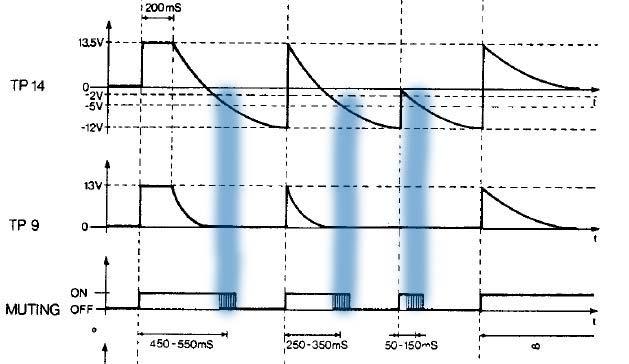Home › Forums › Product Discussion & Questions › BeoMaster › Beomaster 4400 – Sudden drop in sound?
- This topic has 49 replies, 5 voices, and was last updated 3 years, 1 month ago by

-
AuthorPosts
-
3 November 2022 at 18:50 #40299
hcraig244
SILVER MemberYou haven’t said if your measuring a voltage drop when the volume falls down….have you monitored this yet…i so is it falling off?
If you upgrade your membership to silver you will have access to the service manuals for mostly every B&O amplifier available…….
3 November 2022 at 20:28 #40300notwist
BRONZE MemberHmmmm. I checked 208 / 108 and it is very difficult to desolder those fets. They are under the long metal bracket and to get to them I would need to remove the pre-amp and that bracket. Which is far from easy as I recall.
I also find it a bit hard to think that that circuit would fail for both channels. Not impossible but highly unlikely that both channels would suffer the same ‘fate’ due to a failure. Capacitors were all changed into film caps. Leakage is possible but all audio, aside from the massive drop in volume, is still the same (balance, treble, etc). I would expect a different ‘effect’ on each channel. I also still don’t understand why the muting circuit would activate, what triggers it? Is is a certain voltage threshold?
So perhaps the muting circuit is activating, but I just have a hard time wrapping my head around that. Muting is instant, not a dying own effect. That dying down of the audio when the machine is ‘warm’ is what is bothering me, that appears to be of something gradually failing over time.
I just can’t wrap my head around it. I don’t have any clear paths I would take. I can blindly yank stuff out of the machine but that is just nonsense.
Sorry for the rambling but this is such an odd issue that I just don’t know where to start. I’ve already done the basics and those voltages and amps all check out.
Bert
3 November 2022 at 20:44 #40301notwist
BRONZE MemberThe thermistor (R40) reads 50ohms. When I place my industrial worklight over it (that is pretty hot) it slowly, very slowly increases to 52-53 ohms. That seems like a very shallow response, the lamp is much warmer than the heatsink has ever gotten.
Unsure if this thermistor is still doing its work. Unsure whether the ohms reading is good. Nor, if it is indeed broken what replacement is suitable (any PTC thermistor?).
Bert
3 November 2022 at 22:17 #40302Glitch
BRONZE MemberIt seems unlikely that R40 has anything to do with your issue. If R40 triggered the fault circuit, it would open a relay and power would be cut to the +-35V rails. You would get a “relay click” then no sound at all.
It also seems unlikely that the muting circuit would kick in partially and gradually, but it is theoretically possible that the mute FETs get into a partially biased state. You could also monitor TP14 over time. I assume that you have a service manual since it is available online, but if you don’t you can refer to the table posted by hcraig244. It implies that the TP14 is normally a negative voltage and the circuit will mute if it goes positive. I still think that it is unlikely that this is your issue, but IF you can positively rule it out it will be one less thing to consider.
It could be very helpful for those trying to help if you could post data on the actual readings that you are measuring. For example, if you posted that TP14 was -12.0v, -12.1v, -12.2v, -11.7v, -11.5v, measured at a cold power-on and 10 minute intervals, it would be more helpful than saying that “the voltage was good”.
I guess if there is a bright side, it is that your issue is repeatable. Intermittent issues can be much harder to solve.
“When you have eliminated the impossible, whatever remains, however improbable, must be the truth.” – Sherlock Holmes – Sir Arthur Conan Doyle
This context wasn’t the intent of this quote, but it sure seems relevant.
Glitch
4 November 2022 at 07:38 #40303notwist
BRONZE MemberHmmm. Success?!?!?
Okay, I totally understand your point. It is just that I’m loaded with work and trying to ‘do’ my personal machine in between all tasks. Not having a clear working point makes it hard to use the time available in a constructive manner.
You are correct about the voltages but there are just too many points to test. I checked them all and there are no deviations to what is expected in the main voltage rail. Doesn’t mean downstream is problem free but the main, basic voltage providers are working as I expect them to.
Nevertheless, I was able to desolder two of the TR208 fet legs, it is no longer in circuit. I used an angled smd soldering iron and high grade flux to wick those legs under the metal bracket. It took some effort but in the end I was successful.
Now that channel is working problem free. At least the tuner has been running for 1 hour now without a hitch. I will now test if it still works on a higher volume (this test was on a low volume, about 2 on the slider). Will up to 4.
That confirms your hunch that the muting circuit is involved.
Question is, what the hell is actually going on. I would expect this not to be a failure per-se, but perhaps some sort of fine-tuning? Hard to say from the service manual.
Bert
4 November 2022 at 08:40 #40304notwist
BRONZE MemberSo after a long time I think we can conclude it is the muting circuit. For the record, the other channel is still muted (only desoldered TR208). This is on the FM tuner. Will check the situation with a cdplayer or external tuner on that input.
Conclusion: after some time the mute circuit is triggered. But in a ‘delayed’ manner as the audio dies out gradually instead of immediately. Cold machine = working fine, issue appears after 20 minutes on a cold machine start.
Bert
4 November 2022 at 08:57 #40305hcraig244
SILVER MemberAre both your tuning lamps working fine?
4 November 2022 at 09:05 #40306Dillen
ModeratorAre both your tuning lamps working fine?
And of correct types/wattage?
Note that on this Beomaster model, the AFC-button also activates ST (Silent Tuning = quiet between strong stations).
This could be the key here.
Do you have a good antenna?
Tuner aligned properly?
Will it play with the AFC/ST not activated?Martin
4 November 2022 at 13:11 #40307Glitch
BRONZE MemberGlad to hear that you are making progress…Capacitors were all changed into film caps
Does this include 5C15? Did you inadvertently change the timing characteristics of the silent tuning circuit?
The figure showing the relationship between the TP14 signal and the Mute signal could be a clue.
TP14 moving into the range of -2v to -5v would partially enable the mute functionality.
I’m also very curious to hear if this is on just FM or also on the other inputs. I keep an old portable MP3 player on my bench as a source for doing quick tests like this.
Glitch
4 November 2022 at 19:36 #40308notwist
BRONZE MemberCan’t seem to find 5C15, but only the 2.2 and 1 uF capacitors are in film. Everything from 3.3 and above is Vishay electrolytic. When I read the schema the parts corresponding with 5 don’t have a capacitor (but I can’t seem to find C15, will look further).
The lamps all work fine. They are all the correct size and voltage as far as I remember (I inherited a bucket of these lamps). But in the interest of completeness will check them again of course. Might have made a mistake.
Let me check what voltage is provided on TP14. Just a moment ;-).
Problem isn’t an audio provider but the rca-din cable. I have recently cleaned my workspace and as we all know stuff you don’t regularly use gets hidden somewhere. But I remember I have an old Philips cassettedeck I restored and that is DIN so let me check that old beastie.
The FM signal is strong, we live 300 meters away from a big broadcast antenna. Can receive stations here on just a thin piece of wire. But I have an antenna in the beomaster (just a regular dipole). I can try another antenna if necessary.
Bert
4 November 2022 at 21:42 #40309Glitch
BRONZE MemberWhen I mentioned 5C15, it was more of a rhetorical question relating to changing the type of capacitor in a circuit where the capacitor’s ESR might be significant to how the circuit operates. I see that there are other 1 and 2.2 uF capacitors in the muting and tuning circuits. Did you change these from electrolytic to film, or just the capacitors along the audio signal path? I’m not sure if it would make any difference in this particular case, but it might be a detail that could help explain things.
Glitch
5 November 2022 at 06:44 #40310notwist
BRONZE MemberHmm, I think I found 5C15 which appears to be a stray tantalum capacitor (failed to spot this one as I changed all tantalums). That one would have a higher value, likely 10uF. Can you confirm this?
TP14 seems to be behind the pre-amp board. I can take it out but perhaps you can confirm the location?
Bert
5 November 2022 at 06:46 #40311notwist
BRONZE MemberI connected my trusty Philips cassettedeck and can confirm that the audio drop out is also on Tape 1.
In all cases AFC is in the off position.
Bert
5 November 2022 at 06:52 #40312notwist
BRONZE MemberAs to the change of caps to film. I could not sleep so I took that time to do something worthwhile. I changed the caps in the muting circuit of the channel that I did not desolder the fet (108) back to electrolytics.Effect: no change.Bert5 November 2022 at 06:56 #40313notwist
BRONZE MemberProblem persists on the Tape 2 channel. Just wanted to check because Tape 1 has a different layout in the circuit. But no, the problem is on both tape inputs and by extension all inputs.
This all reminds me really badly off that Revox machine I restored where a single damn lamp caused the entire system to mute. Took me hours to realise that was the failure origin. Of course, that was before the google years (which I would loved to have in that era).
Bert
5 November 2022 at 19:14 #40314Glitch
BRONZE MemberThat one would have a higher value, likely 10uF. Can you confirm this?
Per the schematic, 5C15 is 4.7 uF.
I don’t have any other specific suggestions on what to try next. I will usually make enlarged copies of the relevant sections of the schematics and make notes on it (voltages, if something seems hot, etc.). I try to capture anywhere where B&O calls out a test point since if it was significant to the engineers at B&O, it is likely significant to me.
I would also recheck for cold solder joints and cracked circuit boards. Sometimes removing the board is the only way to be thorough. This also has the advantage in that one could take digital images of the board and inspect an enlarged image on a computer. I usually use a camera to take close-ups then stitch the images together to get a lot of resolution. I have also used a flatbed document scanner for this.
This might be a good application for using freeze spray? I don’t use freeze spray myself since I would rather debug using a FLIR camera. Maybe others can comment on this?
I’m still curious on what the actual voltage is on TP14 when the machine is cold and when it is warm and muted.
Glitch
6 November 2022 at 07:09 #40315notwist
BRONZE MemberTP14 (collector of TR7) measures -4.8 on a cold start but it starts dropping voltage immediately. When the voltage drops below -2.3 the audio also drops out.
The drop-out of the audio is much faster now. Just 2 minutes before it hits -2.3 and the audio drops out.
Bert
6 November 2022 at 09:27 #40316Dillen
ModeratorCheck those lamps.
Correct voltage lamps is not enough.
The important thing is the current draw and their “working pattern” with varying voltages.Does the voltage on TR7 base also change?
Or is it coming from IC1?Martin
6 November 2022 at 14:07 #40317notwist
BRONZE MemberCheck those lamps. Correct voltage lamps is not enough. The important thing is the current draw and their “working pattern” with varying voltages. Does the voltage on TR7 base also change? Or is it coming from IC1? Martin
Hmmm. I don’t understand why the lamps are so important. With a load of pain I was able to remove the 2 tuning lamps. They are just regular lamps. I changed them for a different pair (tried everything from 6v – 12v at 30mA) but the issue is the same.
I don’t think the issue is with the lamps or does b&o use some super duper special lamps? Can’t see why, service manual also seems clear in the lamps needed.
Something is triggering the mute circuit and it mutes literally everything. I will pull those transistors from the circuit first now, see whether they still hold up.
Bert
6 November 2022 at 14:32 #40318Dillen
ModeratorThe discriminator lamps are integrated components in the tuning system.
Look at the schematics and you’ll see how it connects together.Why do you fit 30mA and even 12V lamps when the manual calls for 6V 80mA?
Correct lamps may not be available on every street corner but they are not THAT special, they just
have to stay within certain specs (which means no cheap chinese toy lamps with specs all over the place).And I will ask the two questions again:
Does the voltage on TR7 base also change?
Or is the change in voltage coming from IC1?Martin
-
AuthorPosts
- You must be logged in to reply to this topic.







